Coronation 4 March 1330 Name Philippa Hainault | Mother Joanna of Valois | |
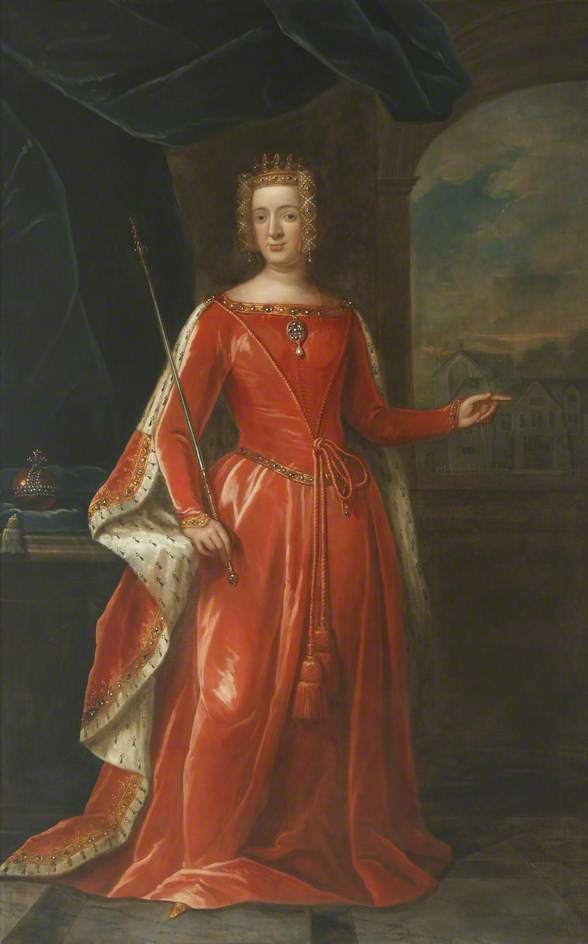 | ||
Tenure 24 January 1328 – 15 August 1369 Born 24 June 1314Valenciennes ( 1314-06-24 ) Issuemore... Edward, the Black PrinceIsabella, Lady of CoucyJoan of EnglandLionel, Duke of ClarenceJohn, Duke of LancasterEdmund, Duke of YorkMary, Duchess of BrittanyMargaret, Countess of PembrokeThomas, Duke of Gloucester Spouse Edward III of England (m. 1328–1369) Children Edward, the Black Prince, John of Gaunt Parents William I, Count of Hainaut, Joan of Valois, Countess of Hainaut Similar People Edward III of England, Edward - the Black Prince, John of Gaunt, Isabella of France, Katherine Swynford | ||
Medieval queens of england philippa of hainault
Philippa of Hainault (Middle French: Philippe de Hainaut; 24 June 1314 – 15 August 1369) was Queen of England as the wife of King Edward III. Edward promised in 1326 to marry her within the following two years. She was married to Edward, first by proxy, when Edward dispatched the Bishop of Coventry "to marry her in his name" in Valenciennes (second city in importance of the county of Hainaut) in October 1327. The marriage was celebrated formally in York Minster on 24 January 1328, some months after Edward's accession to the throne of England. In August 1328, he also fixed his wife's dower.
Contents
- Medieval queens of england philippa of hainault
- Philippa of hainault
- Family
- Betrothal
- Queen of England
- Later years and death
- Issue
- Legacy
- References
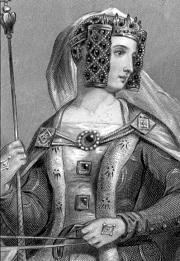
Philippa acted as regent in 1346, when her husband was away from his kingdom, and she often accompanied him on his expeditions to Scotland, France, and Flanders. Philippa won much popularity with the English people for her kindness and compassion, which were demonstrated in 1347 when she successfully persuaded King Edward to spare the lives of the Burghers of Calais. This popularity helped maintain peace in England throughout Edward's long reign. The eldest of her fourteen children was Edward, the Black Prince, who became a renowned military leader. Philippa died at the age of fifty-five from an illness closely related to edema. The Queen's College, Oxford was founded in her honour.
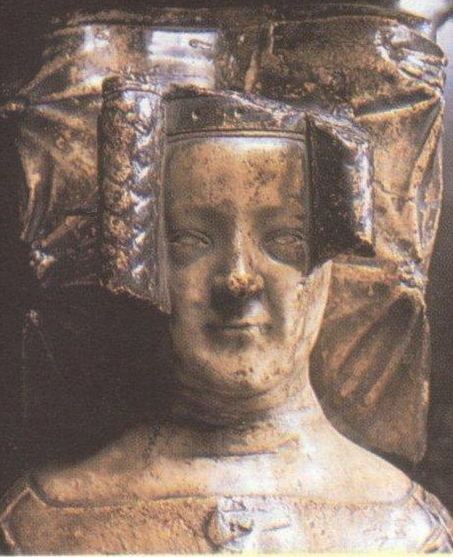
Philippa of hainault
Family
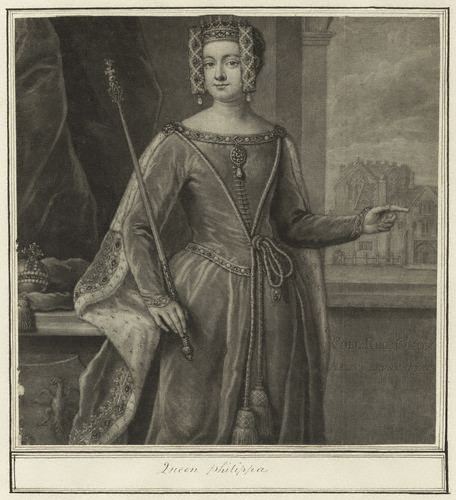
Philippa was born in Valenciennes in the County of Hainaut in the Low Countries, a daughter of William I, Count of Hainaut, and Joan of Valois, Countess of Hainaut, granddaughter of Philip III of France. She was one of eight children and the second of five daughters. Her eldest sister Margaret married the German king Louis IV in 1324; and in 1345, she succeeded their brother William II, Count of Hainaut, upon his death in battle. William's counties of Zealand and Holland as well as of the seigniory of Frieze were devolved to Margaret after agreement between Philippa and her sister. Edward III of England, however, in 1364–65, in the name of his wife Philippa, demanded the return of Hainaut and other inheritances which had been given over to the Dukes of Bavaria–Straubing. He was not successful, as it was the custom in these regions to favour male heirs.
Betrothal
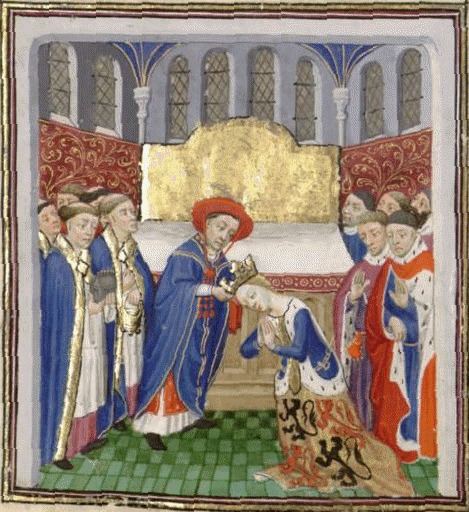
King Edward II had decided that an alliance with Flanders would benefit England and sent Bishop Stapledon of Exeter on the Continent as an ambassador. On his journey, he crossed into the county of Hainaut to inspect the daughters of Count William of Hainaut, to determine which daughter would be the most suitable as an eventual bride for Prince Edward. The bishop's report to the king describes one of the count's daughters in detail. A later annotation says it describes Philippa as a child, but historian Ian Mortimer argues that it is actually an account of her older sister Margaret. The description runs:
The lady whom we saw has not uncomely hair, betwixt blue-black and brown. Her head is clean-shaped; her forehead high and broad, and standing somewhat forward. Her face narrows between the eyes, and the lower part of her face is still more narrow and slender than her forehead. Her eyes are blackish-brown and deep. Her nose is fairly smooth and even, save that it is somewhat broad at the tip and also flattened, and yet it is no snub-nose. Her nostrils are also broad, her mouth fairly wide. Her lips somewhat full, and especially the lower lip. Her teeth which have fallen and grown again are white enough, but the rest are not so white. The lower teeth project a little beyond the upper; yet this is but little seen. Her ears and chin are comely enough. Her neck, shoulders, and all her body are well set and unmaimed; and nought is amiss so far as a man may see. Moreover, she is brown of skin all over, and much like her father; and in all things she is pleasant enough, as it seems to us. And the damsel will be of the age of nine years on St. John's day next to come, as her mother saith. She is neither too tall nor too short for such an age; she is of fair carriage, and well taught in all that becometh her rank, and highly esteemed and well beloved of her father and mother and of all her meinie, in so far as we could inquire and learn the truth.
Four years later Philippa was betrothed to Prince Edward when, in the summer of 1326, Queen Isabella arrived at the Hainaut court seeking aid from Count William to depose King Edward. Prince Edward had accompanied his mother to Hainaut where she arranged the betrothal in exchange for assistance from the count. As the couple were second cousins, a Papal dispensation was required; and it was sent from Pope John XXII at Avignon in September 1327. Philippa and her retinue arrived in England in December 1327 escorted by her uncle, John of Hainaut. On 23 December she reached London where a "rousing reception was accorded her".
Queen of England
Philippa married Edward at York Minster, on 24 January 1328, eleven months after his accession to the English throne; although, the de facto rulers of the kingdom were his mother, Queen Dowager Isabella and her avaricious lover Roger Mortimer, 1st Earl of March, who jointly acted as his regents. Soon after their marriage the couple retired to live at Woodstock Palace in Oxfordshire. Unlike many of her predecessors, Philippa did not alienate the English people by retaining her foreign retinue upon her marriage or by bringing large numbers of foreigners to the English court. As Isabella did not wish to relinquish her own status, Philippa's coronation was postponed for two years. She eventually was crowned queen on 4 March 1330 at Westminster Abbey when she was almost six months pregnant; and she gave birth to her first son, Edward, the following June just nine days before her sixteenth birthday.
In October 1330, King Edward commenced his personal rule when he staged a coup and ordered the arrest of his mother and Mortimer. Shortly afterward, the latter was executed for treason, and Queen Dowager Isabella was sent to Castle Rising in Norfolk, where she spent a number of years under house arrest but with her privileges and freedom of movement later restored to her by her son.
Joshua Barnes, a medieval writer, said "Queen Philippa was a very good and charming person who exceeded most ladies for sweetness of nature and virtuous disposition." Chronicler Jean Froissart described her as "The most gentle Queen, most liberal, and most courteous that ever was Queen in her days."
Philippa accompanied Edward on his expeditions to Scotland, and the European continent in his early campaigns of the Hundred Years War where she won acclaim for her gentle nature and compassion. She is best remembered as the kind woman who, in 1347, persuaded her husband to spare the lives of the Burghers of Calais, whom he had planned to execute as an example to the townspeople following his successful siege of that city.
She served as regent of England during the absence of her spouse in 1346. Facing a Scottish invasion, she gathered the English army and met the Scots in a successful battle near Neville's Cross: she rallied the English soldiers on horse before them prior to the battle, which resulted in an English victory and the Scottish king being taken prisoner. She influenced the king to take an interest in the nation's commercial expansion. Philippa was a patron of the chronicler Jean Froissart, and she owned several illuminated manuscripts, one of which currently is housed in the national library in Paris.
Later years and death
Phillipa had given birth to thirteen children and outlived nine of them. Three of her children died of the Black Death in 1348.
On 15 August 1369, Philippa died of an illness similar to edema in Windsor Castle at the age of fifty-five. She was given a state funeral six months later on 9 January 1370 and was interred at Westminster Abbey. Her tomb was placed on the northeast side of the Chapel of Edward the Confessor and on the opposite side of her husband's grandparents Edward I and Eleanor of Castile and great grandfather Henry III. Her alabaster effigy was beautifully executed by sculptor Jean de Liège. Eight years later Edward III died and was buried next to Philippa. By all accounts, her forty-year marriage to Edward had been happy.
Issue
Philippa and Edward had thirteen children, including five sons who lived into adulthood and the rivalry of whose numerous descendants would, in the fifteenth century, bring about the long-running and bloody dynastic wars known as the Wars of the Roses.
Legacy
The Queen's College, Oxford is named after Philippa. It was founded in 1341 by one of her chaplains, Robert de Eglesfield, in her honour.
Philippa is a character in The Accursed Kings, a series of French historical novels by Maurice Druon. She was portrayed by Françoise Burgi in the 1972 French miniseries adaptation of the series, and by Marie de Villepin in the 2005 adaptation.
